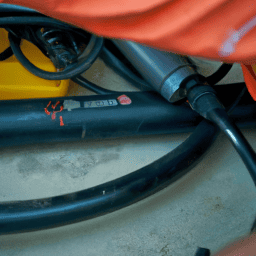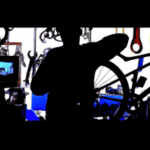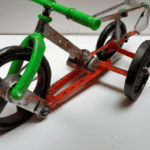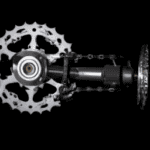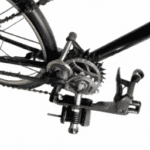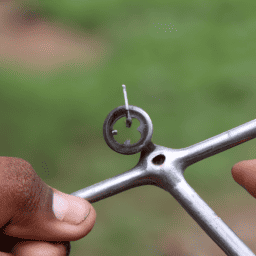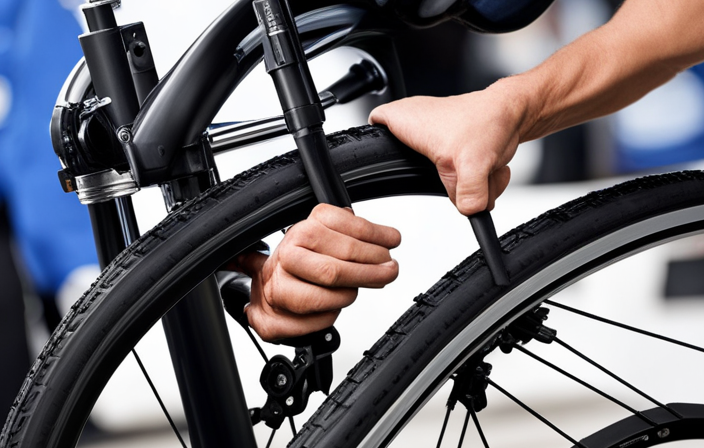Creating a gasoline-powered bike can serve as an excellent project for individuals looking to possess a distinctive and effective means of transport. While it may not be as complex as one might think, it nonetheless demands careful planning and meticulous attention to details.
In this article, I will guide you through the steps of how to make a gas-powered bicycle, from choosing the right engine to maintaining it for years to come.
The first step in making a gas-powered bicycle is to choose the right engine. There are many types of engines available, but you need to find one that is compatible with your bicycle frame and can provide the power you need.
Once you have the engine, you need to prepare your bicycle by removing any unnecessary parts and making sure it is in good condition. Then, you can install the engine and test and adjust it to make sure it’s running smoothly.
Finally, it’s important to maintain your gas-powered bicycle to ensure it continues to run efficiently and safely. By following these steps, you can have a gas-powered bicycle that is both fun and practical to ride.
Key Takeaways
- Choosing the right engine is crucial for fuel efficiency and personal preferences.
- Proper installation and positioning of the engine, along with correct attachment of cables and hardware, ensures stability and a smooth ride.
- Regular maintenance, including oil changes and lubrication, is essential for optimal performance and safety.
- Gas engines have higher fuel efficiency and power, but require more maintenance, while electric engines are better for the environment and have lower maintenance costs.
Choose the Right Engine
Picking the perfect engine is key to creating a gas-powered bike that’ll rev your heart and get you moving with ease! When it comes to choosing an engine for your bicycle, there are a few things to consider.
Fuel efficiency is one of the most important factors to look at. Gas engines tend to have a higher fuel efficiency compared to electric engines, which means you can go further on a single tank of gas. However, electric engines are better for the environment and have lower maintenance costs.
Another factor to consider when choosing an engine is the pros and cons of electric versus gas engines for bicycles. Electric engines are much quieter and produce zero emissions, making them a better choice for those who want to be environmentally conscious. On the other hand, gas engines tend to have more power and can go faster. They also have a longer lifespan and are easier to maintain.
Ultimately, the decision of which engine to choose will depend on your personal preferences and needs.
Now that you’ve chosen your engine, it’s time to prepare your bicycle for the conversion process.
Prepare Your Bicycle
First, I’ll remove the pedals and crankset from my bicycle to make room for the engine. This involves using a pedal wrench to loosen the bolts and then sliding them off the crank arms.
Next, I’ll install the engine mounting bracket onto the frame of my bike. This will require some drilling and attaching bolts to securely fasten it in place.
Finally, I’ll attach the throttle and clutch cables to the engine and handlebars, respectively, so that I can control the speed and power of my gas-powered bicycle.
Remove Pedals and Crankset
Before beginning, make sure to properly prepare and protect yourself before proceeding to pry off the pedals and crankset with a powerful prybar. If you’re not comfortable using a prybar, there are alternative tools such as a pedal wrench or crank puller that can make the job easier. Once you have the right tool, start by removing the pedals with a counterclockwise turn.
With the pedals off, it’s time to remove the crankset. Begin by loosening the bolts that hold the chainrings in place. Once the bolts are loose, use your prybar to gently pry the crankset off the bike. If you don’t plan on repurposing your old crankset, you can simply discard it.
However, if you do plan on reusing it, be sure to store it in a safe place until you need it again. With the pedals and crankset removed, you’re now ready to install the engine mounting bracket.
Install Engine Mounting Bracket
Now that the pedals and crankset have been removed, it’s time to attach the engine mounting bracket. This is a critical step in the process, as it will ensure that the motor is securely held in place and that there is no unwanted movement during operation.
Choosing the right materials for the bracket is important, as it needs to be strong enough to support the weight of the engine while also being lightweight enough to not add unnecessary bulk to the bike. Many people choose to use aluminum or steel for the bracket, as these materials are both durable and lightweight.
In addition to choosing the right materials, it may also be necessary to modify the bracket design to ensure a perfect fit for your specific bike and engine. This can involve measuring and cutting the bracket to fit the frame of your bike, as well as drilling holes to accommodate the mounting bolts.
Once the bracket is in place, it’s important to double-check that everything is securely fastened and that there is no movement or wobbling. With the engine mounting bracket securely in place, it’s time to move on to attaching the throttle and clutch cables.
As we move on to attaching the throttle and clutch cables, it’s important to keep in mind that these components play a critical role in controlling the motor and ensuring a smooth ride. With the engine mounting bracket firmly in place, we can now focus on the details of attaching these cables and making sure that they are properly adjusted for maximum performance.
Attach Throttle and Clutch Cables
With the engine mounting bracket securely in place, it’s time to smoothly connect the throttle and clutch cables. These cables are essential to control the engine’s speed and power, so it’s crucial to install them correctly.
First, I routed the cables through the designated holes and adjusted their tension according to the manufacturer’s specifications. I found that too much tension could cause the engine to rev too high, while too little could make it stall easily. Once I had found the right balance, I secured the cables to their respective connectors and tested their responsiveness.
Cable routing is also important when attaching the throttle and clutch cables. I made sure to avoid any sharp bends or kinks that could interfere with their movement. I also kept them away from the exhaust and other hot components to prevent damage or melting.
With the cables properly attached and routed, I was confident that my gas-powered bicycle would perform optimally. Next, I’ll proceed to install the engine to complete the build.
Install the Engine
Now that I’ve got all the necessary tools and materials, it’s time to install the engine onto my bicycle.
One of the most important steps is to position the engine correctly, ensuring that it’s centered and aligned with the chain.
Once in place, I need to secure the engine to the mounting bracket using the bolts and nuts provided.
Finally, I’ll need to connect the fuel lines and electrical wiring to the engine, making sure they’re properly attached and secure before testing the engine.
Position the Engine Correctly
To ensure optimal performance, it’s crucial to position the engine correctly on your gas-powered bicycle. The engine displacement and weight distribution are two factors you need to consider when positioning the engine.
The engine displacement should be compatible with the size and weight of the bicycle. A larger engine can provide more power, but it can also cause the bike to become unstable and harder to control. On the other hand, a smaller engine may not provide enough power to move the bike.
Weight distribution is also important to consider when positioning the engine. The engine should be placed in a position that will not cause the bike to become unbalanced. If the engine is too heavy and placed too far forward, the front wheel may lift off the ground, making it difficult to steer. On the other hand, if the engine is placed too far back, the bike may become difficult to control, especially when going uphill.
Once you have determined the correct position for your engine, you can move on to securing it to the mounting bracket.
Secure the Engine to the Mounting Bracket
Once you’ve determined the perfect position for your engine, you’ll feel confident securing it to the mounting bracket and hitting the road with ease.
Before you start, make sure you have all the necessary hardware for securing the engine. This will include bolts, washers, and nuts that are the correct size and length for your specific engine and mounting bracket.
When securing the engine, it’s important to ensure stability. This can be achieved by tightening the bolts to the recommended torque specification and double-checking that the engine is level and centered.
Once the engine is securely fastened to the mounting bracket, you can move on to connecting the fuel lines and electrical wiring.
Connect Fuel Lines and Electrical Wiring
After securing the engine to the mounting bracket, you’ll want to connect the fuel lines and electrical wiring to ensure your ride is both efficient and safe. Here are the steps to follow:
-
Connect the fuel tank to the carburetor using a fuel line. Make sure the connections are tight and secure to prevent fuel leaks.
-
Connect the spark plug wire from the engine to the spark plug. This will ensure the engine is able to ignite the fuel properly.
-
Connect any other necessary electrical wiring, such as for the headlight or horn. Refer to the manufacturer’s instructions for specific wiring diagrams.
-
Before starting the engine, double-check all connections to make sure they are secure. It’s also a good idea to check the fuel level and oil level, and to make sure the throttle and brakes are working properly.
Remember to take safety precautions when working with fuel and electrical wiring. Always wear protective gloves and eyewear, and work in a well-ventilated area. If you encounter any issues with your fuel or electrical connections, refer to troubleshooting tips in the manufacturer’s instructions.
Now that your fuel lines and electrical wiring are connected, it’s time to test and adjust the engine to make sure it’s running smoothly.
Test and Adjust
Now that we’ve installed the engine, it’s time to test and adjust it.
First, I’ll check for any leaks or loose connections by inspecting the fuel lines, carburetor, and exhaust system.
Once I’m confident there are no issues, I’ll start the engine and take it for a test ride. I’ll make note of any performance issues that need to be addressed.
From there, I’ll make necessary adjustments to improve the engine’s performance. This may include adjusting the carburetor or changing the spark plug.
Check for Any Leaks or Loose Connections
First, you’ll want to check for any leaks or loose connections on your gas-powered bicycle. Don’t forget to tighten any loose bolts or screws to ensure a safe ride. Common mistakes when assembling a gas-powered bicycle include improperly installed fuel lines, loose connections, and not tightening bolts and screws.
To troubleshoot any issues, check for fuel leaks or loose connections by inspecting the fuel tank, fuel lines, carburetor, and exhaust system. To ensure the safety of your ride, follow these four steps to check for leaks or loose connections:
-
Inspect the fuel tank and fuel lines for any visible cracks, holes, or leaks.
-
Check the carburetor for any loose connections and ensure it’s properly installed.
-
Examine the exhaust system for any leaks or loose connections.
-
Tighten any loose bolts or screws that may be causing the issue.
Once you have checked for any leaks or loose connections, it’s time to start the engine and test ride your gas-powered bicycle.
Start the Engine and Test Ride
Get ready to feel the rush of the wind in your hair as you ignite the engine and take your newly assembled ride for a spin around the block. Before you do, however, it’s essential to perform some engine troubleshooting and safety precautions to ensure that your ride is safe and efficient.
First, check the throttle and clutch to ensure they’re working correctly. Next, inspect the brakes to ensure they’re functioning correctly. Once you’ve completed these checks, start the engine and let it run for a few minutes to warm up. Take your time to listen for any unusual sounds or vibrations. If you detect any, turn off the engine and investigate further before proceeding.
Once you’re satisfied, put on your helmet and safety gear and take your bike for a test ride. Ensure that you have a clear path to ride on and that you’re within the speed limits. If you notice any issues during your test ride, immediately stop the bike, turn off the engine, and make necessary adjustments to improve performance.
Make Necessary Adjustments to Improve Performance
Once you’ve taken your test ride, you’ll want to fine-tune your ride to perfection, so you can experience the thrill of flying down the road like a bolt of lightning. Performance tuning your gas-powered bicycle can be a bit tricky, but with these troubleshooting tips, you’ll be able to make the necessary adjustments to improve your ride’s performance.
First, check your fuel mixture. The ideal fuel mixture for a gas-powered bicycle is 40:1, meaning 40 parts gasoline to 1 part oil. Adjust your fuel mixture accordingly based on your ride’s performance.
Second, adjust your spark plug gap. A gap that is too wide or too narrow can cause misfires and a decrease in performance.
Lastly, make sure your carburetor is clean and functioning properly. A dirty carburetor can cause a number of performance issues, including decreased acceleration and poor fuel economy.
By following these troubleshooting tips, you’ll be able to fine-tune your gas-powered bicycle to perfection.
Ensuring that your gas-powered bicycle is maintained properly is key to keeping it running smoothly. Now that you’ve made the necessary adjustments to improve performance, it’s important to regularly maintain your ride to prevent any issues from arising.
Maintain Your Gas-Powered Bicycle
As a gas-powered bicycle owner, I know that regular maintenance is crucial to keep it running smoothly and safely.
Three key areas to focus on are oil, moving parts, and worn out parts. I make sure to regularly check and change the oil, clean and lubricate the moving parts, and replace any worn out parts as needed.
By following these steps, I can extend the life of my gas-powered bicycle and ensure that it continues to perform at its best.
Regularly Check and Change Oil
Don’t neglect the engine’s health by failing to check and change the oil regularly, or you’ll risk your gas-powered bicycle breaking down on a deserted road. Proper oil maintenance is crucial in extending the life of your engine and ensuring it runs smoothly.
Choosing the right type of oil for your engine is also important, as using the wrong one can cause damage and reduce performance. Here are some reasons why you should regularly check and change your oil:
-
Prevent engine wear and tear: Regular oil changes keep your engine parts lubricated and minimize friction between them. This prevents wear and tear and extends the life of your engine.
-
Improve fuel efficiency: Dirty oil can increase friction in your engine, which can reduce fuel efficiency. Regular oil changes can help maintain your engine’s performance and improve fuel economy.
-
Avoid costly repairs: Neglecting oil changes can lead to serious engine problems, such as overheating or seizing. These repairs can be expensive and time-consuming, so it’s best to avoid them by regularly checking and changing your oil.
To keep your gas-powered bicycle running smoothly, you should also clean and lubricate moving parts. This helps prevent rust and corrosion and ensures that your bike operates efficiently.
Clean and Lubricate Moving Parts
Proper maintenance of your gas-powered bicycle’s moving parts is crucial to ensure that it operates smoothly and efficiently. The importance of regular maintenance can’t be overstated because it prevents unnecessary wear and tear on the bike and can extend its lifespan.
Keeping the moving parts clean and lubricated is a critical aspect of bike maintenance that should not be overlooked. Using high-quality lubricants is essential to maintain the integrity of your bike’s moving parts. Not only does this help reduce friction, but it also protects against corrosion and rust.
A well-lubricated bike will operate more smoothly and efficiently, leading to a more enjoyable ride. The benefits of using high-quality lubricants can’t be overstated because they help keep your bike in top condition for longer. With proper maintenance, you can extend the life of your bike and avoid costly repairs down the line.
In the next section, we will discuss the importance of replacing worn-out parts as needed.
Replace Worn Out Parts as Needed
After cleaning and lubricating the moving parts of my gas powered bicycle, I always inspect the components to see if any parts need replacing. This is an important step in ensuring that the bike runs smoothly and safely.
Over time, parts can wear out and become less effective, which can cause problems while riding. Therefore, it’s crucial to replace worn out parts as needed to maintain the bike’s functionality.
To do this, I follow a simple process which involves inspecting all the components of the bike, identifying any worn out parts, and replacing them with new ones. Here are the steps I take to replace worn out parts:
- Inspect all the components of the bike, including the engine, wheels, brakes, and chain.
- Look for signs of wear and tear, such as cracks, rust, or frayed cables.
- Identify any parts that need replacing, and make a list of the parts required.
- Replace the worn out parts with new ones, ensuring that they fit properly and are secured tightly.
By following these steps, I can ensure that my gas powered bicycle remains in good condition. This process is known as preventative maintenance, and it’s essential for keeping the bike running smoothly and safely.
Frequently Asked Questions
What is the maximum speed that a gas-powered bicycle can reach?
I’ve found that the top speed of a gas-powered bicycle varies depending on its specific make and model. However, with performance upgrades such as a larger engine or improved exhaust, it’s possible to reach speeds of up to 50 mph.
How much does it cost to convert a regular bicycle into a gas-powered one?
Coincidentally, I was just researching the cost of converting a regular bicycle into a gas-powered one. Conversion options range from DIY kits for around $200 to professional installations for over $1000.
Are there any legal requirements or restrictions for riding a gas-powered bicycle on public roads?
When riding a gas-powered bicycle on public roads, there are legal implications and safety concerns to consider. It is important to check local laws and regulations regarding motorized bicycles and to wear appropriate safety gear.
How long does the fuel last in a gas-powered bicycle and how often does it need to be refueled?
When I rode my gas-powered bicycle, I noticed the fuel lasted about 2 hours of continuous use. Fuel consumption depends on the engine size and power output. I refueled every 2-3 rides, or about every 50 miles.
Can the engine be easily removed or detached from the bicycle for maintenance or repair purposes?
Yes, the engine can be easily removed from the bicycle for maintenance or repair purposes. Its durability is dependent on proper maintenance and regular oil changes. Neglecting engine maintenance can cause premature wear and damage.
Conclusion
In conclusion, making a gas-powered bicycle may seem daunting, but it can be a rewarding experience with the right preparation and guidance.
As I installed the engine onto my bicycle, I felt a sense of accomplishment and excitement for the possibilities that lay ahead.
I encourage anyone interested in creating their own gas-powered bicycle to take the time to research and gather the necessary materials. With attention to detail and regular maintenance, this unique mode of transportation can provide a thrilling and efficient way to travel.
So, get ready to hit the road and enjoy the thrill of your powered-up bicycle! As the saying goes, "Life is a journey, enjoy the ride."
